Hikvision – Hikvision announces a new partnership with Can’nX to enhance KNX-based building automation
March 21, 2024 – Hikvision has announced a technology partnership with Can’nX, a leading enabler of automation solutions for commercial and residential buildings.
The collaboration enables Hikvision technologies to be integrated with the KNX protocol – the global standard for home and building automation.
Thanks to the collaboration, integrators can enhance their building automation solutions by integrating Hikvision AI-enabled devices, such as cameras, into building systems – increasing the efficiency of building management and improving overall security.
Can’nX develops KNX IP gateways that make controlling the lighting, heating, ventilation, air conditioning, and other building systems easier. One of these – the Link’nX gateway – allows IoT devices to connect to systems built upon KNX. The KNX IP gateways and IoT devices are configured and controlled with Can’nX’s cloud platform, which enables Hikvision equipment and other assets to be controlled remotely.
The exciting new possibilities of linking Hikvision with KNX
With the new partnership, Hikvision’s advanced AI cameras have become an essential component within the Can’nX KNX ecosystem. It means that system integrators can now take full advantage of machine perception and multi-device coordination to improve security and building automation.
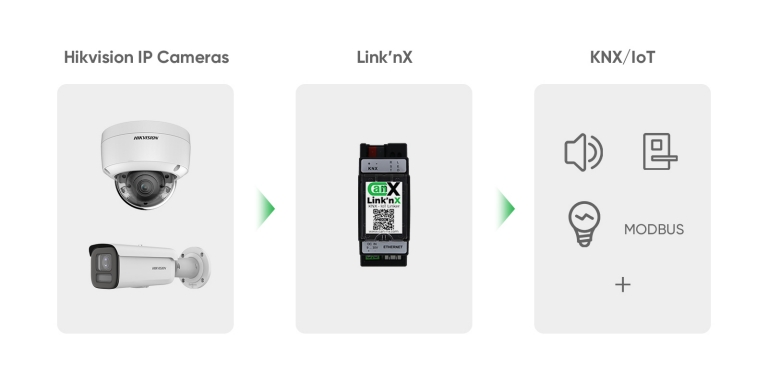
According to Nicolas Colombi, the CEO of Can’nX, the new partnership with Hikvision is a significant step toward expanding the capabilities of the smart home/building ecosystem.
“Our innovative solutions enable different systems to work together through the Link’nX gateway,” he says. “The ability to connect the KNX ecosystem of home automation products to Hikvision devices now enables integrators to provide a broad range of new capabilities, opening up exciting possibilities for enhancing the experience of smart homes and commercial buildings.”
“We’re very optimistic about what the future holds for this collaboration,” says Felix Fu, Global Technology Partner Alliance Manager at Hikvision. “By integrating Can’nX’s KNX ecosystem with Hikvision’s market-proven cameras for AI analytics, we’re providing users with greater security and flexibility in building automation. Our joint solutions pave the way for more exciting and innovative AI-powered applications in the future.”
A range of joint solutions
The partnership with Can’nX provides a range of exciting possibilities. The joint solutions include:
- Integration of Hikvision vehicle access control and automation with KNX
- This solution integrates Hikvision Automatic Number Plate Recognition (ANPR) technology with KNX, the global standard for home and building automation. Find out more here.
- Integration of Hikvision facial recognition technology with KNX
- Similar to the ANPR solution, AI-driven facial recognition can be used as the trigger to multiple automated KNX events. Find out more here.
- Integration of Hikvision privacy mask technology with KNX
- This is a sophisticated security solution which safeguards personal and confidential spaces while maintaining a high level of security awareness. Find out more here.
- Integration of Hikvision intrusion, motion, line crossing, region entry and exit detection with KNX
- This integration solution enables buildings which conform to the KNX standard to incorporate a comprehensive suite of Hikvision’s cutting-edge video security technologies. Find out more here.
Example: Integrating Hikvision’s vehicle access control and automation with a KNX ecosystem
A good example of what is now possible with this partnership would be a series of events that could be triggered by a house owner arriving home. When their car arrives at the garage, Hikvision’s ANPR camera identifies the license plate and triggers a series of events pre-programmed by the Can’nX KNX system. The front door, for example, could be unlocked and lights could be turned on to a particular color and intensity. Meanwhile, the air conditioner could be instructed to create a certain temperature, and the system could even be programmed to turn the TV on in the living room. With the new Hikvision/Can’nX partnership, all of this can be configured to happen completely automatically as soon as the house owner arrives home.
Find out more
Contact us directly for more information about how the world of KNX building automation can be linked with Hikvision technologies, thanks to the new partnership with Can’nX.
SourceHikvision
EMR Analysis
More information on HikVision: See the full profile on EMR Executive Services
More information on Hu Yangzhong (President & Chief Executive Officer, Hikvision): See the full profile on EMR Executive Services
More information on Felix Fu (Global Technology Partner Alliance Manager, Hikvision): N.A.
More information on Can’nX: https://can-nx.com/?lang=en + Our vision : Global Integration… Going beyond KNX
It is our Leitmotiv, to develop open and communicating products that revolutionize the world of integration in the smart home & building environment, from home automation to BMS (Building Management System). Our approach involves taking into account the requirements and limitations of the industry, while leveraging cutting-edge technologies to create innovative solutions that enable you to achieve your objectives more efficiently and effectively. By doing so, we empower you to exceed expectations and fulfill any demand with ease, both now and in the future. As our living spaces become increasingly connected and digital, the importance of using KNX technology is more pronounced than ever. With its status as the sole genuine standard in the building industry, KNX offers a reliable and effective solution for managing and controlling various building functions.
Despite the benefits brought by connected and IoT solutions, integrating and interoperating these new functions into our daily lives can be incredibly challenging. As a result, it’s becoming increasingly difficult to ensure that these solutions work together seamlessly to provide a cohesive experience.It was therefore essential to bring these two worlds together to achieve an Augmented KNX…
With our Can’nX solutions, it’s possible to design, implement, and optimize connected building systems with ease. Our solutions provide a comprehensive set of tools that allow you to streamline the process of creating connected systems, ensuring that they function optimally from the outset.
More information on Nicolas Colombi (Chief Executive Officer, Can’nX): https://www.linkedin.com/in/nicolas-colombi-397657b9/
More information on KNX (KNX is an Abbreviation for the Word Konnex): https://www.knx.org/knx-en/for-professionals/ + Whether you want to control lighting, shutters, security systems, energy management, heating, ventilation, air-conditioning systems, signaling and monitoring systems, interfaces to service and building control systems, remote control, audio and video control,… All these functions work via an uniform system. This is called the principle of interworking. This is home and building control made easy. This is KNX.
In May 1999 members of the following associations founded KNX Association cvba:
- EIBA ( European Installation Bus Association)
- EHSA (European Home Systems Association)
- BCI (BatiBUS Club International)
The Association is the owner of the Worldwide STANDARD for Home and Building Control: KNX and also the owner of the KNX trademark logo worldwide. KNX Association is a non-profit-oriented organisation governed by Belgian Law. Members are manufacturers developing devices for several applications for home and building control based on KNX like lighting control, shutter control, heating, ventilation, air conditioning, energy management, metering, monitoring, alarm/intrusion systems, household appliances, audio/video and lots more. Next to manufacturers also service providers (utilities, telecom, …) can become a member of the KNX Association.
Next to its members, KNX Association has concluded partnership agreements with more than 75.000 partners in more than 164 countries worldwide.
EMR Additional Notes:
- Building Services Engineering
- The duty of Building Services Engineers is to design and determine the most suitable building services installations for a building and to make sure the systems function properly, so as to provide users with a safe, comfortable, and modern life.
- Building services engineers are responsible for the design, installation, operation and monitoring of the technical services in buildings (including HVAC Engineering, mechanical, electrical, also known as MEP or HVAC), in order to ensure the safe, comfortable and environmentally friendly operation.
- System Integrator:
- A systems integrator is an individual or business that builds computing systems for clients by combining hardware, software, networking and storage products from multiple vendors. Using a systems integrator, a company can align cheaper, preconfigured components and commercial off-the-shelf software to meet key business goals, as opposed to more expensive, customized implementations that may require original programming or manufacturing unique components.
- Hiring a systems integrator to combine various subsystems into an integrated offering can also simplify contracting and vendor management for the customer, who would otherwise need to purchase each subsystem separately and work with multiple vendors. Systems integration is, thus, both a procurement method and a technical activity.
- AI – Artificial Intelligence:
- https://searchenterpriseai.techtarget.com/definition/AI-Artificial-Intelligence +
- Artificial intelligence is the simulation of human intelligence processes by machines, especially computer systems.
- As the hype around AI has accelerated, vendors have been scrambling to promote how their products and services use AI. Often what they refer to as AI is simply one component of AI, such as machine learning. AI requires a foundation of specialized hardware and software for writing and training machine learning algorithms. No one programming language is synonymous with AI, but well a few, including Python, R and Java, are popular.
- In general, AI systems work by ingesting large amounts of labeled training data, analyzing the data for correlations and patterns, and using these patterns to make predictions about future states. In this way, a chatbot that is fed examples of text chats can learn to produce lifelike exchanges with people, or an image recognition tool can learn to identify and describe objects in images by reviewing millions of examples.
- AI programming focuses on three cognitive skills: learning, reasoning and self-correction.
- What are the 4 types of artificial intelligence?
- Type 1: Reactive machines. These AI systems have no memory and are task specific. An example is Deep Blue, the IBM chess program that beat Garry Kasparov in the 1990s. Deep Blue can identify pieces on the chessboard and make predictions, but because it has no memory, it cannot use past experiences to inform future ones.
- Type 2: Limited memory. These AI systems have memory, so they can use past experiences to inform future decisions. Some of the decision-making functions in self-driving cars are designed this way.
- Type 3: Theory of mind. Theory of mind is a psychology term. When applied to AI, it means that the system would have the social intelligence to understand emotions. This type of AI will be able to infer human intentions and predict behavior, a necessary skill for AI systems to become integral members of human teams.
- Type 4: Self-awareness. In this category, AI systems have a sense of self, which gives them consciousness. Machines with self-awareness understand their own current state. This type of AI does not yet exist.
- Machine Learning (ML):
- Developed to mimic human intelligence, it lets the machines learn independently by ingesting vast amounts of data, statistics formulas and detecting patterns.
- ML allows software applications to become more accurate at predicting outcomes without being explicitly programmed to do so.
- ML algorithms use historical data as input to predict new output values.
- Recommendation engines are a common use case for ML. Other uses include fraud detection, spam filtering, business process automation (BPA) and predictive maintenance.
- Classical ML is often categorized by how an algorithm learns to become more accurate in its predictions. There are four basic approaches: supervised learning, unsupervised learning, semi-supervised learning and reinforcement learning.
- Deep Learning (DL):
- Subset of machine learning, Deep Learning enabled much smarter results than were originally possible with ML. Face recognition is a good example.
- DL makes use of layers of information processing, each gradually learning more and more complex representations of data. The early layers may learn about colors, the next ones about shapes, the following about combinations of those shapes, and finally actual objects. DL demonstrated a breakthrough in object recognition.
- DL is currently the most sophisticated AI architecture we have developed.
- Computer Vision (CV):
- Computer vision is a field of artificial intelligence that enables computers and systems to derive meaningful information from digital images, videos and other visual inputs — and take actions or make recommendations based on that information.
- The most well-known case of this today is Google’s Translate, which can take an image of anything — from menus to signboards — and convert it into text that the program then translates into the user’s native language.
- Machine Vision (MV):
- Machine Vision is the ability of a computer to see; it employs one or more video cameras, analog-to-digital conversion and digital signal processing. The resulting data goes to a computer or robot controller. Machine Vision is similar in complexity to Voice Recognition.
- MV uses the latest AI technologies to give industrial equipment the ability to see and analyze tasks in smart manufacturing, quality control, and worker safety.
- Computer Vision systems can gain valuable information from images, videos, and other visuals, whereas Machine Vision systems rely on the image captured by the system’s camera. Another difference is that Computer Vision systems are commonly used to extract and use as much data as possible about an object.
- Generative AI (GenAI):
- Generative AI technology generates outputs based on some kind of input – often a prompt supplied by a person. Some GenAI tools work in one medium, such as turning text inputs into text outputs, for example. With the public release of ChatGPT in late November 2022, the world at large was introduced to an AI app capable of creating text that sounded more authentic and less artificial than any previous generation of computer-crafted text.
- https://searchenterpriseai.techtarget.com/definition/AI-Artificial-Intelligence +
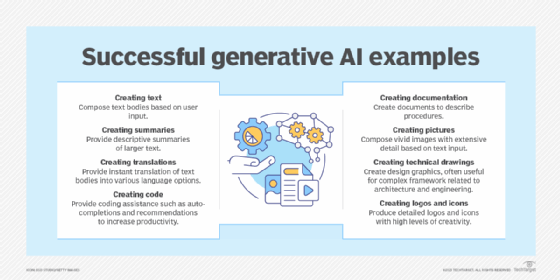
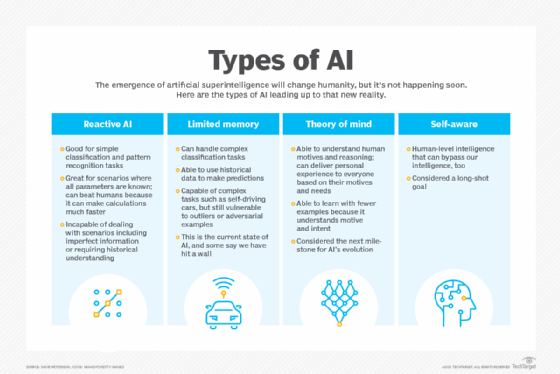
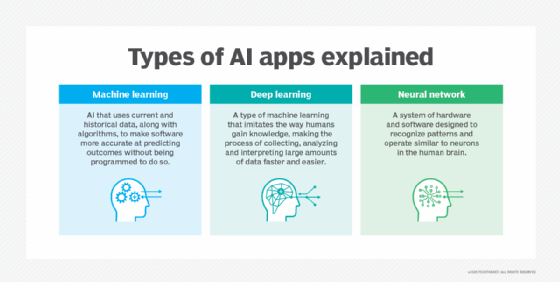
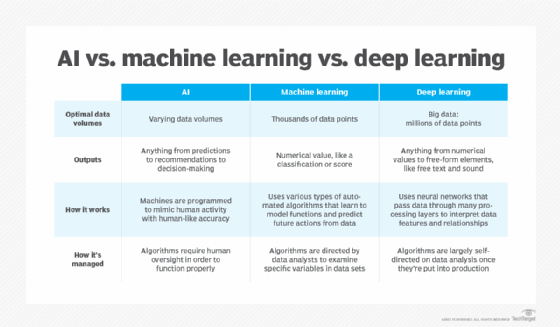
- Edge AI Technology:
- Edge artificial intelligence refers to the deployment of AI algorithms and AI models directly on local edge devices such as sensors or Internet of Things (IoT) devices, which enables real-time data processing and analysis without constant reliance on cloud infrastructure.
- Simply stated, edge AI, or “AI on the edge“, refers to the combination of edge computing and artificial intelligence to execute machine learning tasks directly on interconnected edge devices. Edge computing allows for data to be stored close to the device location, and AI algorithms enable the data to be processed right on the network edge, with or without an internet connection. This facilitates the processing of data within milliseconds, providing real-time feedback.
- Self-driving cars, wearable devices, security cameras, and smart home appliances are among the technologies that leverage edge AI capabilities to promptly deliver users with real-time information when it is most essential.
- TCP (Transmission Control Protocol):
- TCP is a standard that defines how to establish and maintain a network conversation by which applications can exchange data. TCP works with the Internet Protocol (IP), which defines how computers send packets of data to each other.
- IP Communication:
- The Internet Protocol (IP) is defined as the protocol for sending data from one computer to another across the Internet, with each computer having at least one IP address that identifies it from all other computers on the Internet.
- There are two versions of IP that currently coexist in the global Internet: IP version 4 (IPv4) and IP version 6 (IPv6). The majority of current internets use IPv4. The most obvious difference is that IPv4 uses a 32-bit address while IPv6 uses a 128-bit address. This means that IPv6 offers 1,028 times more addresses than IPv4, which essentially solves the “running out of addresses” problem (at least for the foreseeable future).
- MoIP, or mobile communications over internet protocol, is the mobilization of peer-to-peer communications including chat and talk using internet protocol via standard mobile communications applications including 3G, 4G, 5G, GPRS, Wi-Fi …
- Voice over Internet Protocol (VoIP), is a technology that allows you to make voice calls using a broadband Internet connection instead of a regular (or analog) phone line.
- IoT (Internet of Things):
- The Internet of Things (IoT) refers to a system of interrelated, internet-connected objects that are able to collect and transfer data over a wireless network without human intervention.
- Describes the network of physical objects—“things”—that are embedded with sensors, software, and other technologies for the purpose of connecting and exchanging data with other devices and systems over the internet.
- The Most Popular IoT Devices are:
- Smart watches are the most popular IoT devices. …
- Gaming consoles. …
- Smart TV sets and content streaming devices. …
- Voice control devices. …
- Printers. …
- Cameras. …
- Lighting appliances. …
- Smart thermostats.
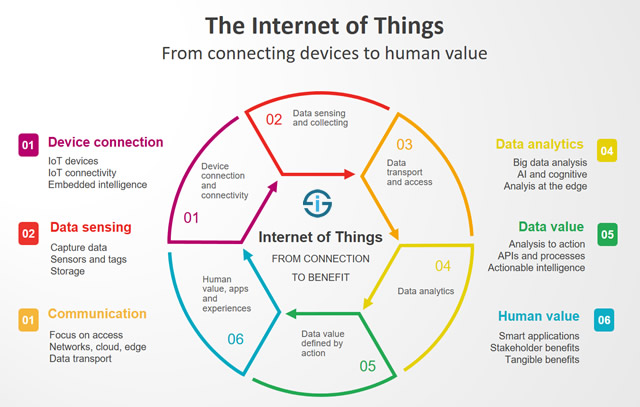

- IIoT (Industrial IoT):
- Industrial IoT (IIoT) involves collecting and analyzing sensor-generated data to support equipment monitoring and maintenance, production process analytics and control, and more. In manufacturing IT since 1989, ScienceSoft offers IIoT consulting and development to create secure IIoT solutions.
- xIoT (xTended Internet of Things):
- xIoT refers to the “xTended” Internet of Things. This xTended IoT category spans Enterprise IoT devices (cameras, printers, and door controllers), OT devices (like PLCs, HMI’s, and robotics) and Network devices (like switches, WiFi routers, and NAS).
- ANPR Cameras:
- ANPR stands for Automatic Number Plate Recognition.
- It’s a technology that reads vehicle registration plates to create location data.
- This information is captured by scanners or cameras then cross-referenced for a range of traffic and law enforcement purposes. ANPR technology converts an image of a number plate into machine-encoded text, this is called optical character recognition.
- The technology can be used across CCTV, traffic enforcement cameras and ANPR-specific cameras. Infrared illumination can help cameras to capture a clearer image.



